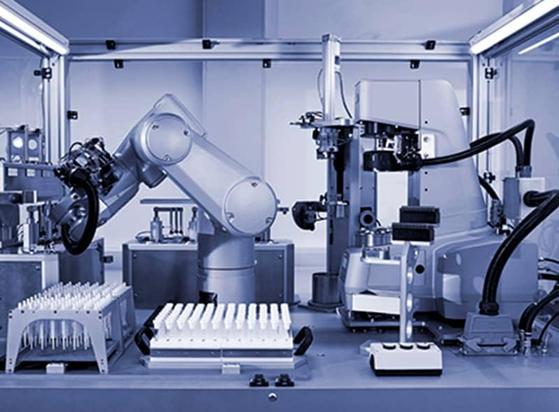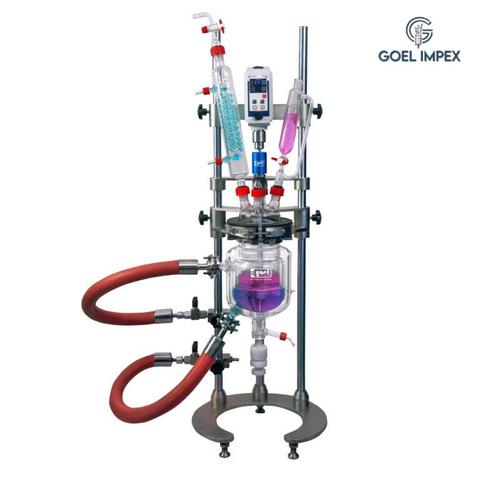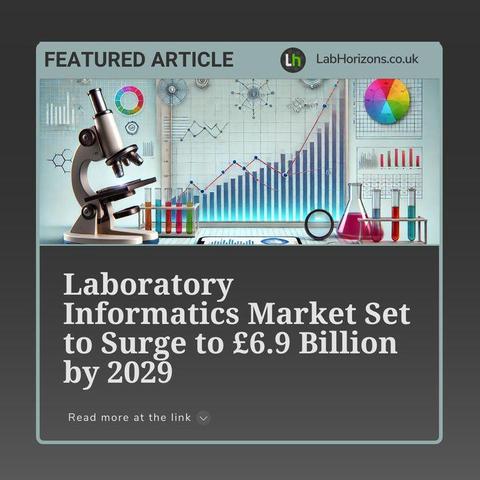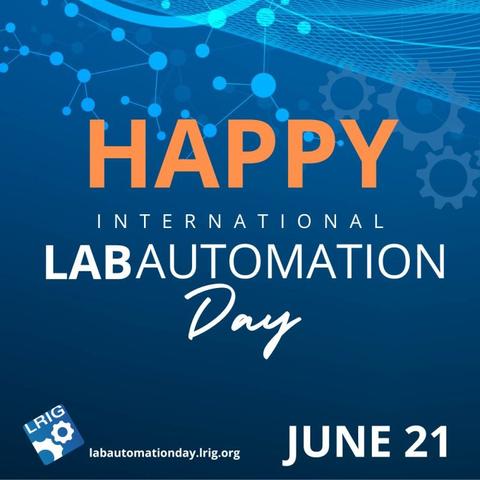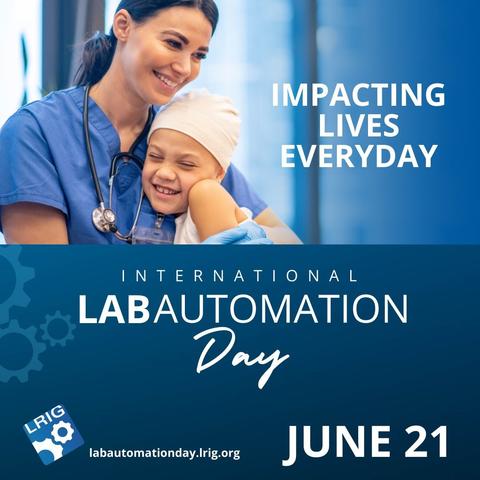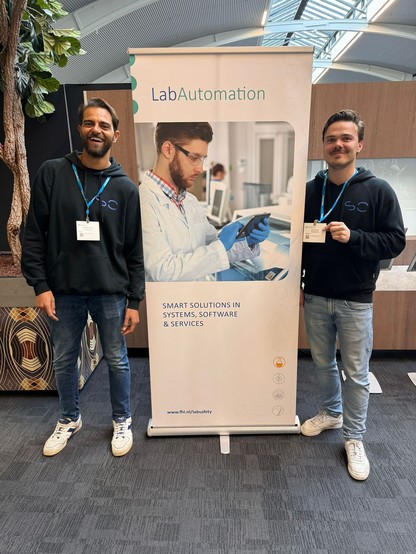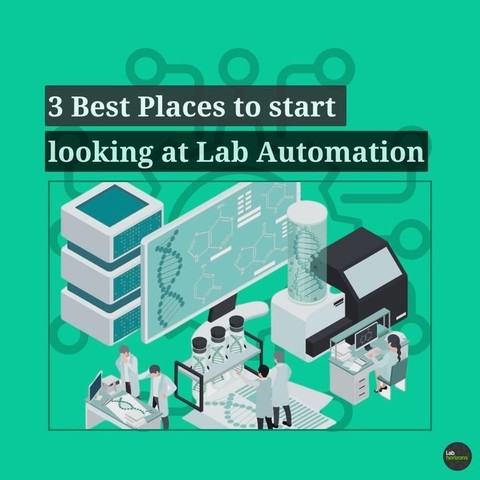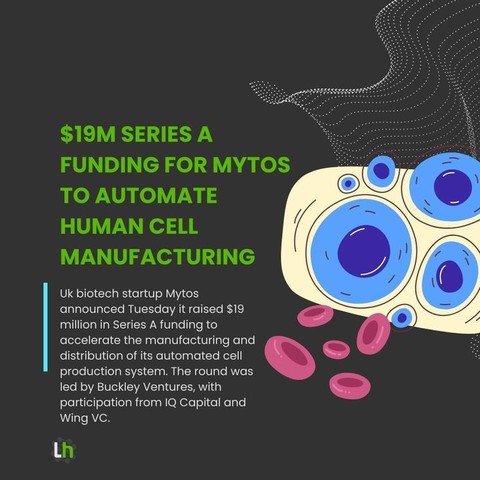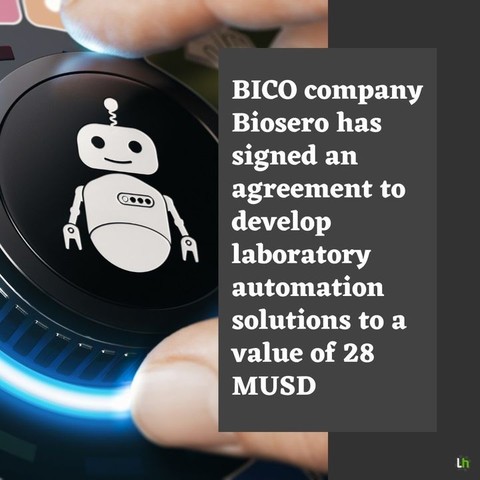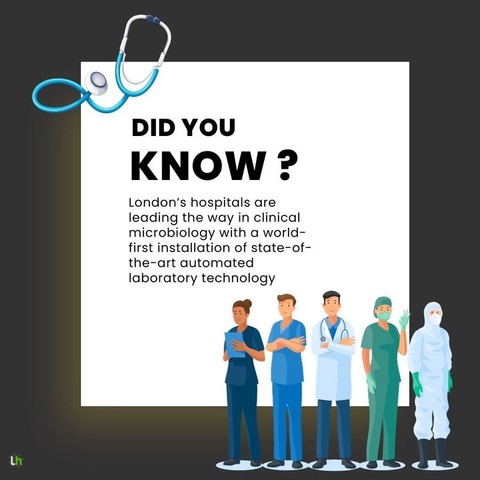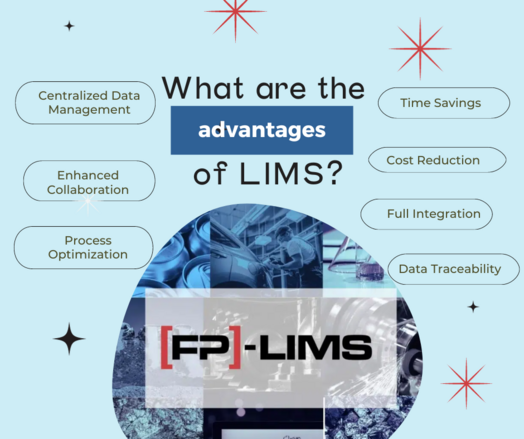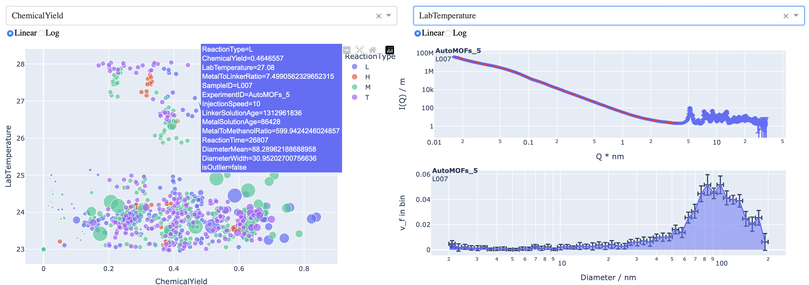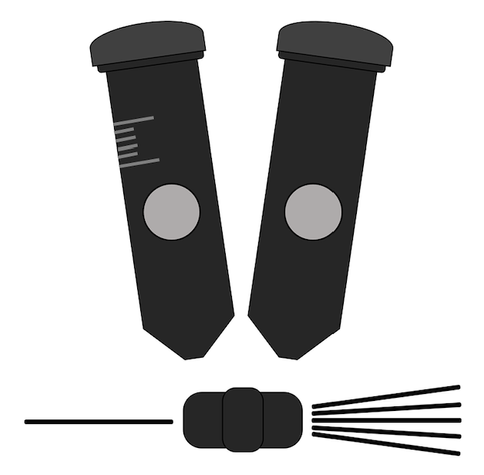Dank des Bioreaktors läuft ein Großteil der Routinekultur nun standardisiert & reproduzierbar – und wir können uns stärker auf Analyse & Weiterentwicklung konzentrieren. ➡️ Ich zeige euch gleich, wie das System aussieht. #Organoide #LabAutomation #RealScientistsDE
#labautomation
The global Lab Automation Market is driven by increasing need for efficient laboratory processes
The global Lab Automation Market is estimated to be valued at US$ 4,903.9 million in 2022 and is expected to exhibit a CAGR of 4.9% over the forecast period 2022 to 2030.
Get more insights on, Lab Automation Market- https://timessquarereporter.com/business/lab-automation-market-is-estimated-to-witness-high-growth-owing-to-advancements-in-robotics
#CoherentMarketInsights #LabAutomationMarket #LabAutomation #LabAutomationMarketInsights #Microplatereader
A 3D-printed robot built with open-source tech is bringing automated materials synthesis to labs around the world—at a fraction of the cost. #OpenSourceScience #LabAutomation #MaterialsInnovation
https://geekoo.news/this-3d-printed-robot-could-revolutionize-materials-science/
Benchtop Reactor Systems | Automation for Every Lab
cutting-edge benchtop reactor systems designed to streamline laboratory processes with advanced automation. Our compact and efficient reactors enhance chemical synthesis, process development, and material research, ensuring precise control over reaction parameters.
#BenchtopReactors #LabAutomation #ChemicalSynthesis
About More information: https://goelequipments.com/benchtop-lab-reactor/
We have a new preprint and GitHub page up describing OT-Mation, a script to move experimental arrays generated using statistical Design of Experiments (#DoE) directly in to code to control the OpenTrons OT-2 liquid handling robotics platform. This reduces programming time for the OT-2 and helps prevent inclusion of incorrect experimental combinations in the script.
preprint on biorxiv:
https://www.biorxiv.org/content/10.1101/2025.01.20.633898v1
Four years after publishing my work on machine-driven parameter screen of biochemical reactions, it still has zero citations. That makes me sad; I am really proud of this work. So I asked ChatGPT to suggest me hashtags, for another chance to reach readers. https://academic.oup.com/nar/article/48/7/e37/5728495 #MolecularBiology #BiochemicalReactions #ReverseTranscription #RNASequencing #LabAutomation #GeneExpression #SingleCellAnalysis #HighThroughput #AIinScience #ComputationalBiology #BiotechInnovation #DataDrivenResearch
Automation and cloud adoption are transforming labs worldwide! See how the laboratory informatics market is projected to reach £6.9 billion by 2029. 📊
Read more.... 🔗 https://labhorizons.co.uk/2024/09/laboratory-informatics-market-set-to-surge-to-6-9-billion-by-2029/
#News #Research #Science #Lab #Laboratory #Innovation #Informatics #LabAutomation
We can build more effective scientific automation systems from the bottom-up!
I've been working on an open-source automation integration model, and I want to hear what you think of it.
#opensource #automation #labautomation #science
https://www.autobio.blog/open-source-integration-will-give-you-super-powers/
Today is International LabAutomation Day! Let's embrace the wonders of automation that have revolutionized our labs, making groundbreaking research possible. It's a day to acknowledge the genius minds and cutting-edge technologies that are propelling us into a new era of scientific discovery. Celebrate with us!
To learn more: labautomationday.lrig.org
#InternationalLabAutomationDay #LabAutomationDay #LRIG #LabAutomation #Automation
Lab automation is not just about technology; it's about the impact on healthcare, drug discovery, and beyond. On International LabAutomation Day, let's reflect on how automation accelerates us toward a healthier future.
To learn more: labautomationday.lrig.org
#ImpactfulInnovation #InternationalLabAutomationDay #LabAutomationDay #LRIG #LabAutomation #LaboratoryAutomation #LaboratoryRobotics #LabRobotics #LabRobot #Automation #SampleManagement
Whether you’re a seasoned researcher or new to the field, knowing where to find the best resources for lab automation is crucial. Automation is a shiny buzz word and it can be hard to know how to even get started understanding it. So to help you get started here are our top 3 ways to catch up with lab automation.
Read more 🖇️ https://labhorizons.co.uk/2024/01/3-best-places-to-start-looking-at-lab-automation/
#LabHorizons #labmanagement #automation #labautomation #research #laboratory
Last week was wonderful!
On the 19th, we attended #LabAutomation in Den Bosch and showcased #ASCENSCIA as an automation solution.👩🔬
2 days later, we packed our bags and traveled to Paris to attend #HelloTomorrow summit on 21-22 March where we shared our perspective on #deeptech!
So what is Lab Automation? We've covered all about it in our new article! Read the full article here: https://labhorizons.co.uk/2024/02/demystifying-lab-automation-a-guide-to-the-past-present-future/
#LabHorizons #LabManagement #LabAutomation #Science #Research
Whether you’re a seasoned researcher or new to the field, knowing where to find the best resources for lab automation is crucial. To help you get started here are our top 3 ways to catch up with lab automation ▶️ https://bit.ly/3NVv6ru
#labmanagement #labhorizons #automation #labautomation #research
Founded in 2018 Mytos has developed a first-of-its-kind platform that fully automates the intricate process of human cell production, which is essential for drug development but painstaking when done manually. The funding will help bring Mytos’ technology to more pharmaceutical and biotech companies looking to speed up their R&D.
Read the complete article 👉 https://labhorizons.co.uk/2023/12/19m-series-a-funding-for-mytos-to-automate-human-cell-manufacturing/
#mytos #cellbiology #labhorizons #genetics #automation #labautomation #technology #innovation
Biosero has signed an agreement with a global life science company for a total value of 28 MUSD to design and build an automated R&D, hardware and software platform which consists of 5 sub-projects.
#labautomation #automation #lab #research #labhorizons #biosero #technolgy #solution #development #lifescience #technology
London Health Sciences Centre and St. Joseph’s Heath Care London are celebrating the installation of a Total Laboratory Automation system within the clinical microbiology laboratory.
“The automated system will allow us to accommodate increased volumes in diagnostic testing and innovations within the system will help optimize productivity of staff, test accuracy, and the time required to report a test result,” says Dr. Jeff Fuller, Division Head, Clinical Microbiology.
🔬🌟 Discover the Advantages of LIMS Software! 🌟🔬
Looking to revolutionize your laboratory operations? Look no further! Check out the amazing benefits of [FP]-LIMS software:
https://bit.ly/3M6dbgC
Those of you who have been around this blog a while, know that we have also been dabbling in laboratory automation (see, for example, this post).
Over the last year or so, led by my former colleague Dr. Glen Smales, we used RoWaN to synthesise over 1200 Zeolitic imidazolate frameworks-8 (ZIF-8) metal-organic framework samples spread over 20 series, while systematically varying many synthesis parameters. Changing seemingly innocuous aspects appears to have a strong impact on the final particle size (distribution), so a correct logging of the metadata is essential for correlating synthesis parameters with morphology.
We have presented this work several times already in various presentations (one of which should go online soon) and large manuscripts are in the works with the full story. Given the scope of this investigation, preparing these manuscripts eats up a lot of time. Today, I would like to focus on how we structured the synthesis metadata that was collected for every sample.
Since small synthesis details might correlate with the resultant particle morphology, we went overboard with the metadata collection. Everything we could think of and get access to, was recorded and integrated in the final structure. This includes such things as bottle opening dates and the humidity in the laboratory. This “everything and the kitchen sink”-approach has saved our bacon a few times in the past when debugging MOUSE measurement issues, and will probably not be out of place here either.
Data Sources
The data sources here were varied, we take what we can get, how we can get it: some data comes from the log of RoWaN itself, which can store such things as EPICS messages as well as step messages (e.g. “Start injection of solution 1”, and “Stop injection of solution 1”) in a long CSV file. Some manual steps were recorded manually using predefined messages in predefined cells in the Jupyter notebook. Some instrument readings (density meter reading for example for the stock solutions) is read manually and added to the log by hand.
Figure 0: The DACHS project logo, because every project needs a logo! Image courtesy of Glen Smales.Data on the starting compounds / chemicals and equipment comes from a master Excel file that contains this information in a structured manner across several sheets. We use Excel because it is a pragmatic user-entry system that does not require any training and whose output can be read with Python. It has severe restrictions, though, that would preclude its use in larger projects and an easily-configurable web form solution is still sought (hook me up when you know of one that can take external yaml or json files specifying configuration of pages, parameters, data types and limits).
Translation, translation, translation
During my last presentation at FAIRmat, there was a good set of questions from the audience about if we can (or should) dictate what, and in what format this metadata should be recorded. At the moment, I would shy away from such efforts. On the one hand, it is impossible to predict what you will need in the end, so I would advise to record everything. On the other hand, any additional workload on an already overloaded workforce is bound to be hated, ignored or forgotten, so chances are that you will not get it as you intended anyway.
Better to encourage recording whatever low-hanging fruit are reachable as automated as possible. You can hook up your heating/stirring plates, syringe injectors, thermometers etcetera to a laboratory network and, with a little effort, continuously read out what they do in whatever format they do it in. Make it as simple as possible to record this, lower the threshold for such documentation, and only require manual documentation if it can somehow absolutely not be avoided. You will get a collection of files and will need to translate that into useful information probably together with some custom knowledge and lots of time stamps. This, in my eyes is unavoidable, although the eventual introduction of a message broker would help greatly. As it is now, we spend a significant portion of our code translating between what we get and what we need, adding some domain knowledge into the code.
We made a piece of software called DACHS that does this. Most of this code defines generic data classes for the various objects and information entries that we want. Values and units, where possible, get translated into unit-aware quantities with Pint, which makes it extremely easy to do unit-aware calculations with, say, moles, grams and millilitres and combinations thereof. The value of this ability cannot be overstated.
One non-generic segment of the code, however, is focused on applying those models to our specific data sources, and to subsequently structure these into a specific tree for this experiment. So what does this tree look like?
The base tree
We decided to split our base tree into three sections: “Equipment”, “Chemicals”, and “Synthesis”, which contain what they say on the tin (Figure 1).
Figure 1: the base tree of the synthesis log HDF5 structure (starting on the right, going deeper to the left)The Equipment section contains a list of the equipment used for that particular experiment (this can vary between experiment series). Equipment includes such things as stirrer bars, Falcon tubes and tubing, as this might correlate to the result. Each equipment has detailed information including which PVs, or “Process Variables” they control. These PVs can contain linear calibration information, i.e. split over a calibration offset and a calibration factor , so that:
The Chemicals section is split into several parts, beginning with the starting compounds. These contain the base reagents as found in the jars of the suppliers. Each reagent has information such as supplier, CAS number and lot number, as well as jar opening date (if known). It also contains information on the chemical in the reagent, with chemical formula, molar mass, density and space group (if known). See Figure 2 for a bit more information on how deep we go with this.
Figure 2: Going into a little more detail in the actual tree using the DAWN DataVis explorer.Limitations
Here, it perhaps behooves to highlight that the solution here is a pragmatic proof-of-principle solution mostly resulting from the effort of less than a handful of people. There are limitations aplenty, for example, there is probably a spate of parameters we are not – but should be – logging.
One thing I could not figure out how to implement easily is equipment interconnectivity. Equipment is connected on several levels: an electrical level (Figure 3), a virtual level (figure 4), and a synthesis-side physical level (tubing etc, Figure 5). So this information is missing from the structure and only exists as vector graphics hand-drawn using the draw.io software. I’m sure there is a better way.
Figure 3: Equipment connections on the physical/electrical levelThen there is the matter of uncertainties. For someone who keeps hammering on about the value of uncertainties and even splitting them up into different classes of uncertainties (“absolute” and “relative”, see the Everything SAXS paper), it is quite hypocritical of me to not have added them here. I decided against it in the end as none of the uncertainty estimates I could come up with were grounded in any sort of realism, i.e. all of them would be guesstimated and therefore would not have any weight to them. Maybe at a later stage it can be improved.
Figure 4: Equipment connectivity on the virtual levelAlso, I had initially provisioned for a more defined synthesis step (called SynthesisStep), which theoretically should allow classifying each synthesis step. This, in turn, should form a good step (ha) towards automatically recreating a synthesis using another robot.
Figure 5: Physical connectivity between equipment from the synthesis perspective (tubing and sample motions as indicated by the solid and dotted lines, respectively). Image by way of Glen Smales.in the end I did not include this as the more I worked with it, the more I realised that most of its purpose is already performed by RawLogMessage. And any universality with other robot systems is moot if I don’t tailor it to use the confines of other robot system concepts.
Here, too, translation will be essential to turn the information contained in these synthesis logs into a synthesis protocol for other robots to use.
So where to go from here?
With the information encapsulated in the synthesis files, we can now start exploring. I’ve built a simple dashboard using Dash and Plotly that allows one to plot parameters against another. Additionally, for samples that have been measured already, the scattering pattern and size distribution can be shown too (indeed, the resultant size parameters are plottable too). This allows a bit more information to be gleaned, but the two-dimensional nature of the plotting isn’t really enough to extricate the necessary interparameter correlations. That will require a bit more effort.
Nevertheless, it’s pretty, and that will suffice for now! (see Figure 6)
Figure 6: The synthesis explorer dashboard. Each dot in the left figure represents a synthesis. For the syntheses whose samples have been measured, the corresponding data, fit and resultant size distribution are shown on the right-hand side.https://lookingatnothing.com/index.php/archives/3720
#archivalData #data #hdf5 #labAutomation #nexus #robotics #storageFormat #synthesis
"Here, we describe a general-purpose tool, WormPicker, a robotic system capable of performing complex genetic manipulations and other tasks by imaging, phenotyping, and transferring C. elegans on standard agar media"
https://academic.oup.com/pnasnexus/article/2/7/pgad197/7218344
